Mauna Kea
At 13,796 feet, Mauna Kea is the top of the Big Island. In fact, its the highest point in all of Hawaii. By day or by night, this spot offers some of the most amazing views you'll ever see anywhere—and it's often missed by visitors.
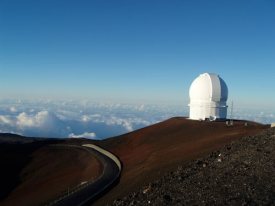 Before I got there, I had no idea that a place like this existed on the Big Island. I hadn't planned on checking it out, but I am so glad that I did. I would definitely rate a trip to the summit in my top 3 things to do on the Big Island.
Before I got there, I had no idea that a place like this existed on the Big Island. I hadn't planned on checking it out, but I am so glad that I did. I would definitely rate a trip to the summit in my top 3 things to do on the Big Island.
Mauna Kea has always been a sacred place for Hawaiians and now it's a sacred place for stargazers too. Once you get to the summit you'll see that Mauna Kea is a serious place for astronomers. At such a high altitude and in such a remote location, the skies above Mauna Kea are some of the darkest and the most clear in the world. If you've ever been out in the country and thought that the stars look bright, wait until you see them from up on Mauna Kea. And before the stars come out you have the chance to see one of the most beautiful sunsets you will ever see.
Visitors are only allowed on the summit up until sunset. Head lights interfere with the telescopes so plan on arriving in time to take in the view and watch the sun set and to be off the summit before dark.
Before setting out for Mauna Kea, make sure that you have everything you need. Temperatures at the summit are cold, even below freezing. Make sure you have warm clothes. You don't need extreme gear but a couple of layers and a warm hat is a good idea (who would have thought to pack warm clothes on a trip to Hawaii?). Also keep in mind that the summit is at high altitude. Going from sea level to nearly 14,000 feet can be hard on some people. The best way to avoid any problems is to take your time. Stop for a while at the visitor's center before going all the way to the top. Up to date road and weather conditions are available by calling 808-935-6268 and listening to the recording.
If you're setting out from Kona, it takes about two hours to get to the summit. So, early afternoon is a good time to leave. Take Highway 190 towards Waimea. You'll come the the Saddle Road just before mile marker 6. Its just about the only major right-hand turn on 190 and its well marked.
So, if you want to check out Mauna Kea on your own and you'll be renting your ride, you'll want to go with Harper. There are also guided tours available that will provide all the transportation.
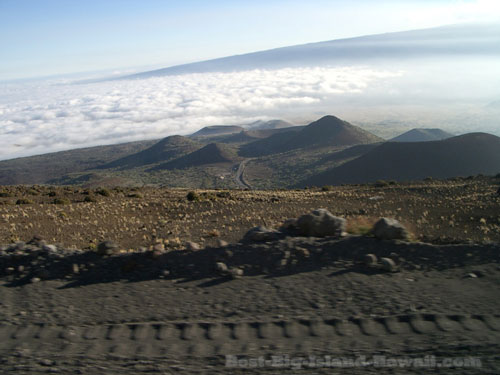 Also, if you are driving, make sure that you fill up before you go. There are no gas or service stations along the way. It's not the kind of place you want to run out of gas. Once you get on the Saddle Road, you're pretty far from all signs of civilization. The Saddle Road is a winding, hilly, two lane highway. It's paved but it can still be dangerous—Especially when visibility is low (which it often is). Take your time and drive carefully.
Also, if you are driving, make sure that you fill up before you go. There are no gas or service stations along the way. It's not the kind of place you want to run out of gas. Once you get on the Saddle Road, you're pretty far from all signs of civilization. The Saddle Road is a winding, hilly, two lane highway. It's paved but it can still be dangerous—Especially when visibility is low (which it often is). Take your time and drive carefully.
The Summit Access Road is just past mile marker 28. There's only a small sign to mark the left hand turn but its pretty hard to miss. As you drive up, you'll be amazed to see that you're above the clouds. On some of the best days that I've been on Mauna Kea, the clouds spread out like a blanket. It's beautiful.
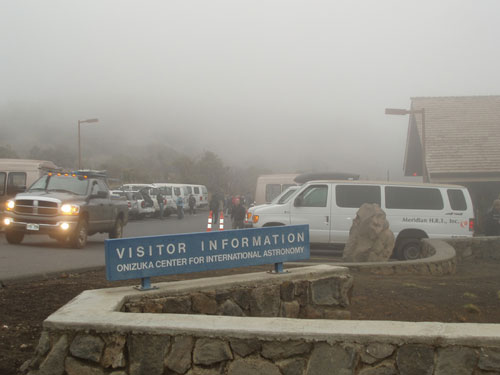 On the way to the top you'll run into the Onizuka Center for International Astronomy—named after Hawaiian astronaut Ellison Onizuka who died on the space shuttle Challenger in 1986. The center is open from 9am to 10pm. This is a great place to stop and get used to the elevation change. They serve coffee, hot chocolate and other snacks. Take the time to check out some of the information on the various telescopes—There's none at the summit. On your way back down after dark you don't want to be inside—You'll want to be out looking at the stars.
On the way to the top you'll run into the Onizuka Center for International Astronomy—named after Hawaiian astronaut Ellison Onizuka who died on the space shuttle Challenger in 1986. The center is open from 9am to 10pm. This is a great place to stop and get used to the elevation change. They serve coffee, hot chocolate and other snacks. Take the time to check out some of the information on the various telescopes—There's none at the summit. On your way back down after dark you don't want to be inside—You'll want to be out looking at the stars.
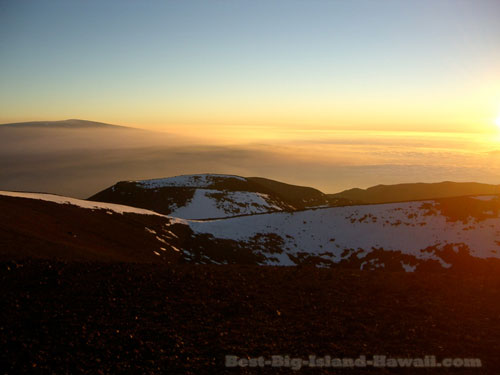
The summit of Mauna Loa
in the distance
If you look south, you can usually see Mauna Loa, the Big Island's second highest peak at 13,677 feet. It's about 30 miles away. If you're there when the sun is setting, look west and enjoy the view. I've seen a lot of breathtaking sunsets in Hawaii—Mauna Kea was one of the best and most memorable. The entire sky was covered by a blanket of clouds as far as I could see in every direction. All you could see was the summit area, the summit of Mauna Loa and the sinking sun.
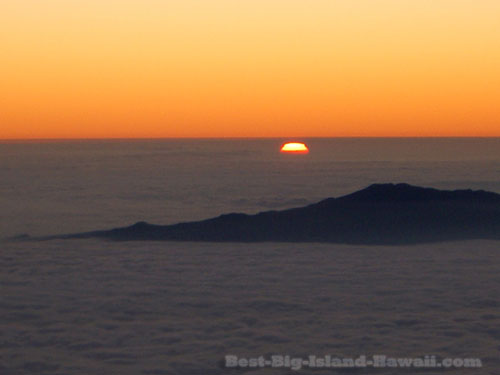
The sun sinks below the clouds
After the sun sets, it starts to get cold quickly. Make your way back down to the Onizuka Center. As it starts to get dark there will be people setting telescopes so that you can have a closer look at the stars. Stargazing depends on the weather, but most nights offer clear skies. The stargazing program runs nightly from 6pm to 10pm and is free. Knowledgeable people, including university students, operate the telescopes and are happy help you see the stars and to explain what you are seeing. One night I got to see Saturn (including the rings) and Mars (which looked orange even to the naked eye. It hard to describe just how full of stars the sky is. I've been in some pretty dark places where the stars were bright, but Mauna Kea leaves them all behind.
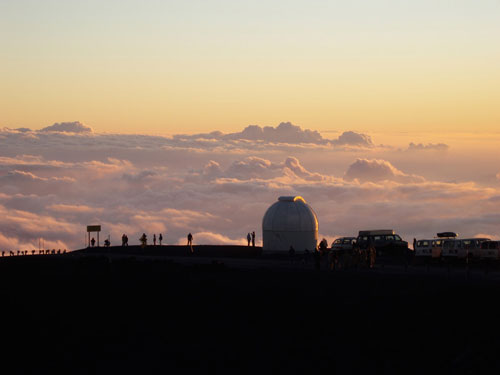
Hiking - It is possible to hike to the summit of if you're the adventurous type. Start at the Onizuka Center and ask about the trail and hiker registration. The climb is about 4,600 vertical feet to the summit. This is an all day activity. The round trip takes about 10 hours. So if you're up for the hike, get started early. The down fall of hiking up is that you have to hike back down before the sun sets.
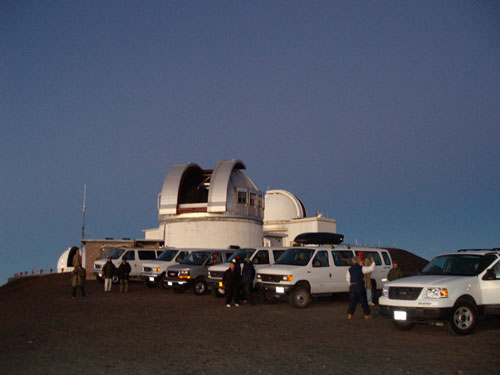
Guided Tours - If you don't have a ride to Mauna Kea, you can go with a tour company like Mauna Kea Summit Adventures. They offer pick-ups in Kailua-Kona or Waikoloa. The cost of the tour is about $200 and includes transportation, food and hot drinks, parkas and gloves, stargazing, and an expert guide. Reservations made two weeks in advance qualify for a 15% discount. This can be a good option for those who have a rental from somewhere other than Harper or would rather leave the driving to someone else.
Even if you get to the top on your own, free guided tours are available at the Onizuka Center. It's best to arrive by 1pm. The tour begins with an orientation at the Visitor's Center, which gives you time to acclimatize. You'll drive up to the summit at about 4:30 where you'll even get to see inside some of the telescopes. Tours depend on weather conditions, so call ahead (808-961-2180).

However you get to the top, I suggest putting a trip up Mauna Kea on your list of Big Island "must do"s. It's is like no place else you've ever been. It is one of the most memorable experiences I have had on the Big Island. And just think, you'll be able to tell your friends that you had a snow ball fight in Hawaii!




